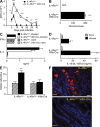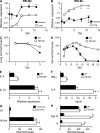Intestinal epithelial cell secretion of RELM-beta protects against gastrointestinal worm infection
- PMID: 19995957
- PMCID: PMC2806463
- DOI: 10.1084/jem.20091268
Intestinal epithelial cell secretion of RELM-beta protects against gastrointestinal worm infection
Abstract
Th2 cells drive protective immunity against most parasitic helminths, but few mechanisms have been demonstrated that facilitate pathogen clearance. We show that IL-4 and IL-13 protect against intestinal lumen-dwelling worms primarily by inducing intestinal epithelial cells (IECs) to differentiate into goblet cells that secrete resistin-like molecule (RELM) beta. RELM-beta is essential for normal spontaneous expulsion and IL-4-induced expulsion of Nippostrongylus brasiliensis and Heligmosomoides polygyrus, which both live in the intestinal lumen, but it does not contribute to immunity against Trichinella spiralis, which lives within IEC. RELM-beta is nontoxic for H. polygyrus in vitro but directly inhibits the ability of worms to feed on host tissues during infection. This decreases H. polygyrus adenosine triphosphate content and fecundity. Importantly, RELM-beta-driven immunity does not require T or B cells, alternative macrophage activation, or increased gut permeability. Thus, we demonstrate a novel mechanism for host protection at the mucosal interface that explains how stimulation of epithelial cells by IL-4 and IL-13 contributes to protection against parasitic helminthes that dwell in the intestinal lumen.
Figures





Similar articles
-
Basophil-mediated protection against gastrointestinal helminths requires IgE-induced cytokine secretion.Proc Natl Acad Sci U S A. 2014 Dec 2;111(48):E5169-77. doi: 10.1073/pnas.1412663111. Epub 2014 Nov 17. Proc Natl Acad Sci U S A. 2014. PMID: 25404305 Free PMC article.
-
Goblet Cell Derived RELM-β Recruits CD4+ T Cells during Infectious Colitis to Promote Protective Intestinal Epithelial Cell Proliferation.PLoS Pathog. 2015 Aug 18;11(8):e1005108. doi: 10.1371/journal.ppat.1005108. eCollection 2015 Aug. PLoS Pathog. 2015. PMID: 26285214 Free PMC article.
-
Variability of the intestinal immunoglobulin E response of rats to infection with Trichinella spiralis, Heligmosomoides polygyrus or Nippostrongylus brasiliensis.Parasite Immunol. 1999 Jun;21(6):287-97. doi: 10.1046/j.1365-3024.1999.00219.x. Parasite Immunol. 1999. PMID: 10354351
-
Interleukin-4- and interleukin-13-mediated host protection against intestinal nematode parasites.Immunol Rev. 2004 Oct;201:139-55. doi: 10.1111/j.0105-2896.2004.00192.x. Immunol Rev. 2004. PMID: 15361238 Review.
-
Animal model of Nippostrongylus brasiliensis and Heligmosomoides polygyrus.Curr Protoc Immunol. 2003 Aug;Chapter 19:Unit 19.12. doi: 10.1002/0471142735.im1912s55. Curr Protoc Immunol. 2003. PMID: 18432905 Review.
Cited by
-
Mechanisms of Disease: Inflammatory Bowel Diseases.Mayo Clin Proc. 2019 Jan;94(1):155-165. doi: 10.1016/j.mayocp.2018.09.013. Mayo Clin Proc. 2019. PMID: 30611442 Free PMC article. Review.
-
Type 2 immunity-dependent reduction of segmented filamentous bacteria in mice infected with the helminthic parasite Nippostrongylus brasiliensis.Microbiome. 2015 Sep 17;3:40. doi: 10.1186/s40168-015-0103-8. Microbiome. 2015. PMID: 26377648 Free PMC article.
-
Basophil-mediated protection against gastrointestinal helminths requires IgE-induced cytokine secretion.Proc Natl Acad Sci U S A. 2014 Dec 2;111(48):E5169-77. doi: 10.1073/pnas.1412663111. Epub 2014 Nov 17. Proc Natl Acad Sci U S A. 2014. PMID: 25404305 Free PMC article.
-
IL-4Rα-associated antigen processing by B cells promotes immunity in Nippostrongylus brasiliensis infection.PLoS Pathog. 2013 Oct;9(10):e1003662. doi: 10.1371/journal.ppat.1003662. Epub 2013 Oct 24. PLoS Pathog. 2013. PMID: 24204255 Free PMC article.
-
Intestinal epithelial tuft cell induction is negated by a murine helminth and its secreted products.J Exp Med. 2022 Jan 3;219(1):e20211140. doi: 10.1084/jem.20211140. Epub 2021 Nov 15. J Exp Med. 2022. PMID: 34779829 Free PMC article.
References
-
- Artis D., Wang M.L., Keilbaugh S.A., He W., Brenes M., Swain G.P., Knight P.A., Donaldson D.D., Lazar M.A., Miller H.R., et al. 2004. RELMbeta/FIZZ2 is a goblet cell-specific immune-effector molecule in the gastrointestinal tract. Proc. Natl. Acad. Sci. USA. 101:13596–13600 10.1073/pnas.0404034101 - DOI - PMC - PubMed
-
- Bansemir A.D., Sukhdeo M.V. 2001. Intestinal distribution of worms and host ingesta in Nippostrongylus brasiliensis. J. Parasitol. 87:1470–1472 - PubMed
Publication types
MeSH terms
Substances
Grants and funding
LinkOut - more resources
Full Text Sources
Molecular Biology Databases

